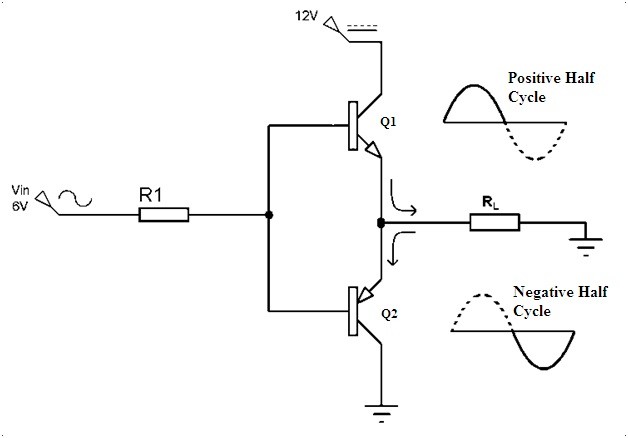Push-pull amplifiers are the combinations of two bipolar junction transistors that is one of P-N-P type and the other is of N-P-N type. In this combination one act as push type and the other acts as pull type. If the single-stage amplifiers are utilized lot of heat dissipation occurs in the circuit and so the efficiency is less though it gives 90% amplification of the input signal.
But where the higher values of efficiency are concerned then these amplifiers with two stages are utilized. One stage is referred to as push where the positive half of the cycle is utilized and at the pull stage, the negative cycle is utilized.
What is a Push-Pull Amplifier?
A amplifier designed with two stages where one is utilizing the positive cycle that is referred to as the push stage and the negative cycle can be pulled at another stage. This design is referred to as the push-pull amplifier or Class B amplifiers.
Push-Pull Amplifiers Circuit Diagram
The push-pull amplifiers are the combination of P-N-P and the N-P-N transistors. This combination has its significance in terms of amplification. It acts as a dual-stage amplifier. The N-P-N transistor here acts as a push amplifier where the positive cycle is amplified. P-N-P in this transistor acts as the pull amplifier where it enacts on the negative cycle of the applied input signal.

Push-Pull Amplifier Circuit Diagram
Push-Pull Amplifiers Working
The push-pull amplifier is designed based on the above circuit diagram. At the input side one single resistor is connected in between both the Q1 and the Q2 transistors. The other resistor that is connected at the output acts as a load. These two transistors can be of type BJT or MOSFET. The one transistor that is connected provides the current to the load as the source. The other transistor that is connected acts in such a way that it sinks the current from the load.
The operation of the push-pull amplifiers is in such a way that it makes the signal to split into the form of out of phase that is 180 degree. At the input one transformer is connected such that it acts as an input coupler. This coupler splits the signal in such a way that one half of the signal is given to one transistor and the other is given to the other transistor. In this way, the push-pull amplifier works.
It can be classified into various types. They are class A, class B, and Class AB. Among all these class B is best suited as the push-pull amplifier.
Class A Amplifier
In this type of configuration, there is only one single transistor present in it. In this case, this transistor is remained ON always. Because of which the distortions are minimum in this case and the amplitude obtained in this is maximum. But the efficiency of this class is very low that is nearly around 30 percent.
Class B Amplifier
This type of amplifier satisfies the condition of the push-pull amplifier. In this case, the two transistors are connected in such a way that each transistor is operated per each half-cycle provided to it. It is good at providing greater efficiency than class A amplifiers.
But it has a drawback that it suffers from the problem of crossover distortion. This occurs because of the dead zone which get created as either of the transistor(NPN or PNP) cannot turns on at the same time. To overcome this problem another class of amplifiers is designed such that these are provided with some interfacing diodes .
Class AB Amplifier
The problem of class B amplifier can be overcome by connecting the diodes in such a way that the diodes are biased just above the value of the cut-off. This helps in the overcoming the problem of cross over distortions.
Push-Pull Amplifier Advantages
The advantages of the push-pull amplifier are as follows:
1. It can eliminate distortions that have been occurred in the circuit.
2. It is capable of generating high gains.
3. As the class B amplifier follows the principle of the push-pull amplifier the efficiency of the circuit is high enough.
4. The transformers that are utilized at the output are less costly and smaller in size.
In this way, the push-pull amplifier has many advantages in terms of gain efficiency and the output power generated. But the condition that must be satisfied for this type of amplifier is that the two transistors that are utilized in this situation apart from being complimentary it must be identical in properties otherwise both positive and the negative halves of the cycles are amplified individually instead of decreasing distortion it tends to increase the distortion values.
Push-Pull Amplifier Applications
This type of amplifier circuit is utilized in many applications. They are:
1. Whenever the matter of low-cost design arises push-pull amplifiers are the best-suited ones.
2. These amplifiers are utilized in RF systems.
3. These amplifiers are also used in digital switching designs.
4. In the cards that are used in mobile phone, computers required for audio amplifications also these amplifiers are used.
5. At the conditions where the power dissipation values should be less these amplifiers are used.
Each amplifier design has its significance in terms of its generation of high-quality output and efficiency gains. The push-pull amplifier designed consists of two stages. One stage acts as a source to the load and the other enact as a sink from the load.
The major criterion of this design is to provide a highly efficient circuit with minimum distortions and low heat dissipation which inturn reduces the usage of heat sink. But there are certain cases where these amplifiers are prone to the harmonic distortions. So depending upon the requirement of the circuit the amplifiers has to be chosen.
Now can you describe whether a class AB amplifier is worth-full in practical applications?
Please refer to this link to know more about Audio amplifier circuit.